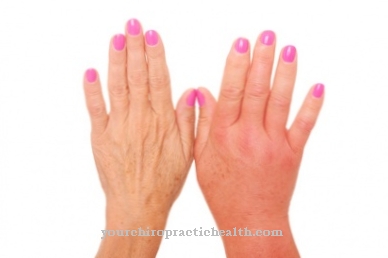A cyanosis, the bluish discoloration of the skin, mucous membranes, lips and fingernails, can be a sign of serious heart or lung disease. Therefore, if a Blue discoloration of the skin and mucous membranes Be sure to consult a doctor to find out the cause and initiate treatment for the cyanosis and the underlying condition.
What is cyanosis?
.jpg)
Cyanosis is the purple or blue coloration of the skin and mucous membranes. Cyanosis can also affect a person's lips and fingernails.
The blue coloration of the skin and mucous membranes often does not appear to the same extent or at the same time on all of the aforementioned parts of the body. Patients who have acute cyanosis can be in a life-threatening condition and urgent medical attention is needed.
The chronic blue discoloration of the skin and mucous membranes, for example the conjunctiva in the eyes, must be taken seriously because it can be a symptom of serious illnesses. A cyanosis should therefore be examined by a doctor as soon as possible.
causes
Cyanosis occurs when there is insufficient oxygen in the blood. The red blood pigment hemoglobin turns blue when there is a lack of oxygen, which explains the bluish coloration of the skin and mucous membrane.
This lack of oxygen can either be attributed to the fact that too little oxygen is being absorbed through the air we breathe, or that the lungs are unable to absorb sufficient oxygen due to certain diseases.
The blue color of the skin and mucous membranes can also be a symptom of heart disease, heart failure, or a result of a heart defect. Lung diseases related to or independent of the heart disease can also cause cyanosis.
Diseases with this symptom
- Heart failure
- Polyglobules
- poisoning
- Heart defect
- Pneumothorax
- Emphysema
- Circulatory disorders
- Bronchiectasis
- Valvular heart disease
Diagnosis & course
Since cyanosis is usually very easy to see, the doctor will first examine the areas of the body where the blue coloration of the skin and mucous membranes occurs. Then the doctor will initiate further diagnostics to find out the cause of the cyanosis.
As the blue color of the skin and mucous membranes can be an indication of a serious heart or lung disease, a comprehensive investigation is essential. After asking the patient about their history, the duration of the cyanosis and any heart and lung diseases that have already been diagnosed, the doctor will listen to the lungs and heart and also have a blood count taken in the laboratory.
In most cases, if the skin and mucous membranes are blue, an ultrasound of the heart and an X-ray of the chest are also made, since the doctor can use these imaging procedures to determine possible changes in the organs.
An EKG and a lung function test provide further information about the condition of both organs. In particularly severe cases of cyanosis, the doctor has other diagnostic options available, such as an MRI or a cardiac catheter examination, with the help of which he can find out the cause of the blue discoloration of the skin and mucous membranes.
Complications
If cyanosis continues chronically, typical complications occur. The cyanosis can lead to a so-called polyglobulia. The low oxygen content in the arteries caused by cyanosis leads to an increase in the production of red blood cells in several intermediate steps. At first this is not a problem. The oxygen can be bound better and there is a lot of oxygen available.
It becomes critical when the blood pigment value, the hematocrit, exceeds a certain limit. From a hematocrit value of 65 percent, the blood becomes very viscous. This results in circulatory disorders in the body periphery. Polyglobules also promote the development of gout. Patients suffering from cyanosis also have an increased need for iron.
Iron deficiency anemia and the resulting tiredness and exhaustion are other possible consequences. There is also the risk of developing so-called watch glass nails and drumstick fingers. The nails on the fingers and the toes can become severely deformed. In addition to the cosmetically unsightly effect, this can result in severe pain for the patient.
Cyanotic patients often have deviating blood coagulation values and therefore have an increased tendency to bleed. Simple wounds can be very dangerous for these patients as they could lose a large amount of blood even through small cuts. Chronic cyanotic patients are also prone to brain abscesses.
When should you go to the doctor?
Cyanosis must definitely be treated by a doctor. As a rule, the treatment is causal and depends on the underlying disease. Since the cyanosis itself can lead to serious complications or, in the worst case, even to the death of the patient, treatment by a doctor is necessary. In general, the patient should see a doctor if the skin suddenly turns blue for no particular reason.
A visit to the doctor is also necessary if you feel dizzy or even have heart problems. It is not uncommon for patients to feel tired and exhausted and can no longer actively participate in life. If these symptoms occur, treatment is essential.
If the cyanosis is caused by breathing difficulties, treatment is also necessary. If there are acute breathing difficulties or gasping, an ambulance must be called or the hospital must be visited directly. Without treatment, cyanosis can lead to a reduced life expectancy.
Doctors & therapists in your area
Treatment & Therapy
Cyanosis is seen as a symptom in the body of a serious heart or lung disease that lowers the amount of oxygen in the blood.
Therefore, when treating the blue discoloration of the skin and mucous membranes, the doctor will orientate himself towards the underlying disease and try to treat it as well as possible. Because the better the disease causing it is treated, the lower the probability that cyanosis will recur.
The treatment options cover a wide range of medicine. For some underlying diseases, drug therapy may be sufficient, while others require surgery.
If the skin and mucous membranes become acutely blue, it is also advisable to supply the patient with oxygen through the nose so that the oxygen supply to the blood is guaranteed and the cyanosis subsides as quickly as possible.
Outlook & forecast
In the worst case, cyanosis can cause discomfort to the heart or lungs. For this reason, the symptom must definitely be examined by a doctor so that there are no consequential damages or serious complications.
In most cases, patients feel weak and unable to perform any physical activity. Everyday life is severely restricted by cyanosis. It can also lead to a loss of consciousness if a heavy load is exerted. Those affected suffer from dizziness and nausea, and headaches are not uncommon.
The cyanosis can also lead to gout. Iron deficiency also leads to severe exhaustion, which cannot be compensated for by sleep. The nails will crack and show signs of deformation. Furthermore, damage to the brain can occur if the cyanosis is not treated properly.
The treatment is carried out causally and is always based on the underlying disease. Surgery may be needed to properly treat the cyanosis. Early treatment can limit further symptoms in the lungs and heart.
prevention
To prevent cyanosis from occurring, it makes sense to have a doctor examine you regularly once a year in order to detect early changes in the heart or lungs. A healthy lifestyle and sporting activities also promote the health of the cardiovascular system and thus prevent cyanosis.
You can do that yourself
The possibilities for self-help with cyanosis depend on the cause. The blue discoloration of the skin or mucous membranes is often caused by serious heart or lung diseases. In these cases, medical help is always necessary. In the case of chronic cyanosis, the doctor will also give appropriate instructions for self-help, which the patient can carry out at home.
Avoiding overexertion is particularly important for the chronically ill patient. Furthermore, it is absolutely necessary to refrain from smoking. Some patients with heart failure or lung disease also have an oxygen machine at home. If necessary, the person affected can supply himself with oxygen-enriched air.
Sometimes the cause of the cyanosis is harmless. Especially when exposed to the cold, the oxygen supply to peripheral parts of the body such as fingertips, the skin or the extremities can be reduced to such an extent by slowing down the blood flow in the capillaries that peripheral cyanosis occurs. A long stay in the cold or in cold water is enough.
In these cases, however, everyone can help themselves. The blood flow really gets going again by warming up the body, as the blood vessels that have been contracted by the cold widen. A hot tea, a warm blanket or a warm bath often helps.



.jpg)




















.jpg)



